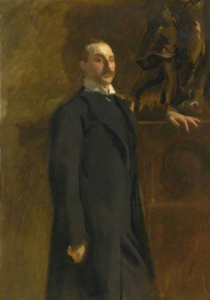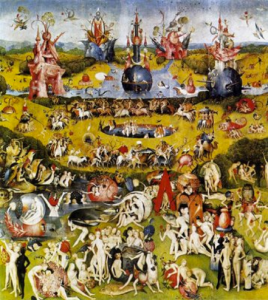The debate over an artist’s responsibility and the function of a work of art brought forth a controversial artistic movement called Art for Art’s Sake, or L’art pour l’art. Many critics believed that true works of art included a moral message and that without it, the best an artist could hope to create was a merely “artistic” work[1]. Artists, however, rejected this responsibility and argued that art did not concern itself with morals and that the quest for pure beauty through form was enough to consider a creation a true work of art. Artists worked with the expectation of an attached moral or meaning, but those who supported the Art for Art movement did not believe that those morals and meanings were inherent. They needed to be prepared by an artist and brought about by a viewer. It has been argued by many critics including John Ruskin that the Art for Art movement was immoral; however, this paper will argue that the nature of art as an object disputes this claim since morality in art is extrinsic rather than intrinsic.
Those who rejected the Art for Art philosophy were wrongly attached to the idea of a work of art’s inherent moral value. John Ruskin took this idea to the extreme when he compared the artist to the preacher. He writes, “both are commentators on infinity, and the duty of both is to take for each discourse one essential truth . . . and to impress that, and that alone, upon those whom they address.”[2] Ruskin clearly believed that morality was the premier goal of art and that beauty and creativity were less important. Unfortunately, assumptions like Ruskin’s misinformed many of the Art for Art movement’s opponents, who wrongly believed that artists looked to purity of form above all else. It follows that their apparent obsession with beauty made these artists hedonists and therefore enemies of morality. This is because, as Irving Singer points out, “in the quest for beauty we are concerned with the surface of experience, with the sensuous presentation of things rather than with the things themselves.”[3] In dealing with the presentation of a thing rather than the substance of a thing, Ruskin and other critics of the Art for Art movement accused artists of purposefully ignoring substance because its implications—consider, for example, the moral implications of depicting a rape scene or a Last Judgment—interfere with the aesthetics of art. They believed that artists like James McNeil Whistler and John Singer Sargent, for example, omitted such “moral” scenes because they held aesthetics to greater esteem than high morality.[4] However, this is not how the artists approached their work.
Many artists and supporters of the Art for Art movement, including Whistler, believed that art itself was amoral, and that any “moral” had to be applied by the viewer. To explain this to Ruskin and his like-minded contemporaries, Whistler stated, “to say to the painter that Nature is to be taken as she is, is to say to the player, that he may sit on the piano.”[5] Just as a musician arranges notes, chords, and harmonies to create a certain mood in a piece, visual artists arrange paint. This is not to say that moral lessons attached to art are bad or unnatural. Rather, these morals are important and enriching to the study and appreciation of art. Long ago it was believed that the artist’s job was to guide the reader to a predetermined moral as best he could. For example, when a Netherlandish viewer regarded the middle panel of Hieronymus Bosch’s The Garden of Earthly Delights (Museo Nacional del Prado) and saw the ring of frenzied horsemen, he would recall the Dutch proverb, “the wicked go in a circle” and would condemn the behavior of the sinners[6]. However, the intentional application of morals disappeared during the Art for Art movement when an artist had more autonomy and could choose to represent whatever he wished. At times this meant that a wide range of (unintentional) morals were imagined by viewers. These different moral views can be explained by Reception Theory.
Reception theorists believe that every time a person comes into contact with a work of art, its meaning is changed because the viewer’s experiences, perceptions, and personal psychology are also changed.[7] Because of unconscious psychological differences, no two people experience a work of art the same way, despite the work’s constant nature. That is to say, paint itself is not moral. No certain color, brushstroke, or line is moral or immoral. Rather, it is the arrangement of these things and the way the viewer perceives this arrangement that prompts him to assign a moral message to the painting. When Bosch painted his sinners, he could be sure that his Dutchman would recognize the sin. But if a modern American viewer were to study the same panel, she would not understand the gravity of those sins in the same way because of a lack of social, historical, and literary context.
It follows that the main focus of the Art for Art movement was to prove that it is not the artist’s responsibility to supply a moral for the viewer since the viewer will undeniably read this moral differently. This is what Immanuel Kant, who “brought [the Art for Art movement] to its climax”[8] means when he proclaims, “free beauty has the quality of “purposiveness without purpose;” a beautiful object has formal purposiveness, but no ulterior purpose”.[9] The artist’s new objective was to show that art itself is not political, but that the viewer, critic, and artist made it political based on their personal psychologies and the sociological conventions ingrained in them.[10] This concept was evidenced by the formal elements of Art for Art paintings. For example, in reference to his painting Arrangement in Grey and Black (Musée D’Orsay) Whistler stated that, “[it] was interesting to him because it was a picture of his mother, but the identity and personal significance of the woman represented was not something about which the public “can or ought to care.””[11] Even though Whistler depicted his mother, he recognized that the viewer would not see his mother. Instead, the viewer would see a painting of a woman who may be Whistler’s mother. The viewer would not see the woman’s personality, hear the sound of her voice, or remember stories from the past. The things that Whistler held so dear about his mother would be lost on the viewer. In this way, Whistler does not really paint his mother, but a woman who looks like her. She only becomes his mother when he looks at the painting and recognizes her essence in his work. Whistler was at peace with the fact that no viewer would experience Arrangement in Grey and Black the same way that he did. If it conjured other feelings for a viewer, Whistler would be content, because he would have proved that the meaning of a work of art is malleable.
Similarly, John Singer Sargent, another proponent of the Art for Art movement, used formal techniques to manifest the effect of viewing on a work of art. Singer Sargent’s application of paint and use of blank space in the Portrait of Edward Wertheimer (The Tate Museum) emphasized the fact that the work was made of paint on canvas. The artist diluted the darker colors with turpentine, as evidenced by the droplets that run down the length of the canvas[12]. Furthermore, his use of a painterly brushstroke emphasizes the physicality of the paint. In other pieces, as well, Singer Sargent applied paint in such a way that it emphasized the form of the painting, rather than the subject. This was how John Singer Sargent demonstrated the main tenet of the Art for Art philosophy: that while a viewer may find a moral in a work of art, the paint itself does not bring this moral about. Conversely, it is the arrangement of the paint and the way the viewer registers its symbolism (purposeful or accidental) that creates a meaning.
Though their intentions were at times misconstrued by critics such as Ruskin, proponents of the Art for Art movement like Whistler and Singer Sargent showed that an artist’s responsibility did not and could not include the creation of a moral or immoral work of art. Rather, that there were just as many available morals as there were viewers of a work of art. In their formal and metaphorical representation, these artists proved that though they were interested in aesthetics, they recognized the importance of reception in finding a morality in a given work of art.
Appendix A:


Paradise/The Garden of Earthly Delights by Hieronymus Bosch (1504)

Bibliography:
[1] A.H. Hannay. “The Concept of Art for Art’s Sake,” Philosophy (1954). 44.
[2] Irving Singer. “The Aesthetics of “Art for Art’s Sake”,” The Journal of Aesthetics and Art Criticism (1954). 349.
[3] Ibid., 345. Emphasis added.
[4] Ibid., 350.
[5] Ibid., 347.
[6] Richard G. Mann. “Rev. of Hieronymus Bosch: Garden of Earthly Delights by Melanie Kiler. Utopian Studies (2005). 153.
[7] Craig A. Hamilton and Ralf Schneider. “From Iser to Turner and Beyond: Reception Theory Meets Cognitive Criticism”. Style 36.4 (2002): 642.
[8] Gene H. Bell-Viada. “The Idea of Art for Art’s Sake: Intellectual Origins, Social Conditions, and Poetic Doctrine”. Science & Society (1986/87). 423.
[9] Ibid., 423.
[10] Craig A. Hamilton and Ralf Schneider. “From Iser to Turner and Beyond: Reception Theory Meets Cognitive Criticism”. 640.
[11] Irving Singer. “The Aesthetics of Art for Art’s Sake”. 351.
[12] Jacqueline Ridge and Joyce Townsend. “John Singer Sargent’s Later Portraits: Application of Paint,” Apollo (2006). Web.
